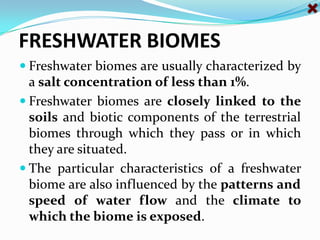
Freshwater biomes
- 1. FRESHWATER BIOMES Freshwater biomes are usually characterized by a salt concentration of less than 1%. Freshwater biomes are closely linked to the soils and biotic components of the terrestrial biomes through which they pass or in which they are situated. The particular characteristics of a freshwater biome are also influenced by the patterns and speed of water flow and the climate to which the biome is exposed.
- 3. Lakes and Ponds Large(Lakes) and Small(Ponds), natural bodies of standing fresh water Formed when depressions in earth’s surface are filled with: Precipitation Runoff Groundwater Large lakes may have many of same characteristics as oceans
- 4. Classification Depending on the amount of organic matter produced.
- 5. OLIGOTROPHIC deep cold small surface area relative to depth nutrient-poor phytoplankton are sparse, not very productive don’t contain much life waters often very clear sediments low in decomposable organic matter
- 6. MESOTROPHIC moderate nutrient content moderate amount of phytoplankton reasonably productive
- 7. EUTROPHIC shallow warm large surface area relative to depth nutrient-rich phytoplankton more plentiful and productive waters often murky high organic matter content in benthos leads to high decomposition rates and potentially low oxygen
- 8. EUTROPHICATION Oligotrophic lakes may develop into eutrophic lakes over time. Runoff from surrounding terrestrial habitats brings in mineral nutrients and sediments. Human activities increase the nutrient content of runoff due to lawn and agricultural fertilizers; municipal wastes dumped into lakes dramatically enriches the nitrogen and phosphorus concentrations which increases phytoplankton and plant growth. Algal blooms and increased plant growth results in more detritus and can lead to oxygen depletion due to increased decomposition.
- 13. WETLANDS areas of standing water that support aquatic plants among the richest biomes for its diverse communities marshes, swamps, and bogs are considered wetlands can be freshwater or saltwater plant species adapted to the very moist and humid conditions are called hydrophytes
- 15. RIVERS and STREAMS bodies of water that move continuously in one direction water changes from their point of origin (headwaters) to where they empty into a larger body of water (mouth) In the headwaters, the water is cold and clear, carries little sediment, and has few mineral nutrients. Near the mouth, water moves slowly and is more turbid due to sediment entering from other streams and erosion; the nutrient content is also higher.
